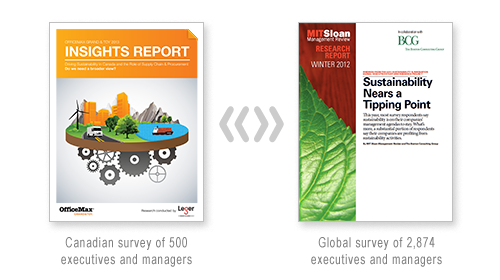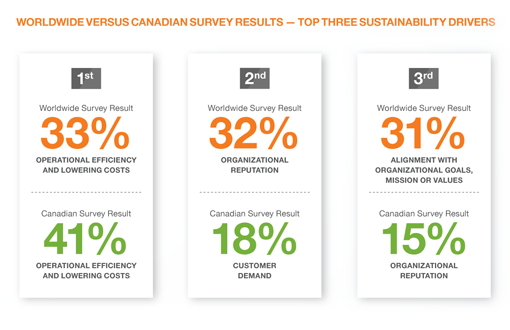![]() .
.

A large scale study by OfficeMax Grand & Toy comparing Canadian companies to their world peers finds Canada leads in capturing cost reduction from sustainability initiatives but lags global leaders in driving profitability through collaboration. Broader collaborations with customers, suppliers, government and policy makers may be a key to unlocking the next phase’s rewards.
As Canadians, most of the industry reports we read focus on the U.S. Other studies cover globally. We may assume the trends and findings also apply to Canada. But do they? For the first time that I am aware of, a large scale study has been conducted that focuses specifically on how Canadian businesses practise sustainability, why they do it, and what their drivers and challenges are.
Conducted by research intelligence firm Leger and co-written by OfficeMax Grand & Toy, the Canadian study asks questions similar to those in the global study conducted by MIT Sloan Management Review and the Boston Consulting Group. Both studies involve large scale surveys and live interviews with practitioners, from Canada and worldwide respectively, in large enterprises across all industries. Comparing the results of these two studies uncover just how Canada is performing and how we rate against our worldwide counterparts.

Canada leads in capturing profitability from sustainability initiatives. When I think of sustainability as a business strategy, it can be used to drive revenue or reduce expense. It turns out Canada is a leader in applying sustainability to the latter. Two departments, Operations and Procurement/Supply Chain, often take the lead to drive the process. Opportunities are uncovered to increase operational efficiencies and lower costs, delivering bottom line benefits through sustainability initiatives. Cost cutting is also perhaps the easiest way to get executive buy-in for sustainability, which is a key ingredient to success.
The MIT study defines the “sustainability tipping point” as “the point at which a substantial portion of organizations are not only seeing the need for sustainable business practices but are also deriving financial benefits from these activities”. The Canadian survey suggests Canada has already reached this “tipping point”.
Over-emphasis on cost reduction may, however, limit future success. One of the more remarkable findings—and there are many in the sixteen-page report which I encourage you to read in full—are the top three sustainability drivers identified by respondents. Canadians largely cited operational efficiency and cost reduction as their top driver. Customer demand and organizational reputation are the distance second and third drivers. Our global peers see things quite differently. The McKinsey & Company survey “The Business of Sustainability” found three equal top drivers for companies worldwide: operational efficiency and cost reduction; organizational reputation; alignment with the company’s business goals, mission, or values.

“What we’re seeing in Canada is a sustainability approach that emphasizes business efficiencies or cost reductions. The advantage to this is that Canadian organizations are among the global leaders in driving profitability from sustainability,” said Warren Shiau, senior researcher and co-author of the Canadian report. “In the long term however, these organizations may face challenges as they try to extend sustainability adoption into other areas of the business where positive impact is harder to measure.”
Broader collaborations could unlock the next phase of rewards. One key difference found between Canadian companies and global leaders is in collaboration. The MIT study finds that global leaders most successful in turning sustainability activities into profits collaborate more than other companies do. When global leaders drive their sustainability strategies, they collaborate extensively with customers, suppliers, government and policy makers, internal business units across functions and geographies, industry associations, to name a few. Edgar Blanco, a research director at the MIT Center for Transportation and Logistics, says that although companies may find this process challenging, it is essential: “If you’re going to focus your strategy on carbon reduction or environmental impact or social impact, you need to engage your suppliers. Without them, you cannot succeed.”
Opportunities exist for procurement and sustainability to reinforce each other. The OfficeMax Grand & Toy study noted life-cycle costing and analysis as an example of a purchase evaluation model that attempts to take into account the overall cost of a product or service over its life to the organization, rather than simply looking at its initial purchase cost. Sustainability departments with operational and reporting expertise can identify and communicate criteria or specifications that would populate lifecycle costing and similar models, helping to create more refined purchase evaluations. Procurement can in turn support sustainability by promoting purchase decisions with a positive or reduced environmental impact.
Collaboration often means stepping outside your comfort zone and reaching out to other groups, whether internal to the company or with external organizations. While this may feel uneasy at first, global leaders have shown that win-win collaboration is a key to unlocking more values from sustainability initiatives. Canada can be proud to claim a leadership position in driving operational efficiency and cost reduction. Now is the time to build longer term values and seize the next phase of rewards in organizational reputation, customer loyalty, corporate culture, and employee engagement.
This article on sustainability in Canada is sponsored by OfficeMax Grand & Toy. All opinions are my own.

What drives sustainability in Canadian companies? Are opportunities for collaboration being missed? via @Carbon49 http://t.co/uIG6eH1YUK
Interesting discussion of this article happening on LinkedIn: http://lnkd.in/KaxhFs
Good Information
[…] Reach out and collaborate with your industry associations and professional associations, says panelist Coro Strandberg of the non-profit organization CBSR. To achieve your bold goals, form partnerships with NGOs, suppliers, and even your competitors. A global study conducted by MIT Sloan Management Review and the Boston Consulting Group found that global leaders most successful in turning sustainability activities into profits collaborate more than other companies do. A similar study by Leger and OfficeMax Grand & Toy found Canadian companies lag behind global leaders in driving profitability through collaboration. (See Sustainability: Canada’s Strengths and Weaknesses.) […]
[…] opportunity. Right now, I don’t think having a green fleet is the norm. As with most corporate green strategies, going in early could present you as an industry leader while doing so later would just be playing […]
[…] opportunity. Right now, I don’t think having a green fleet is the norm. As with most corporate green strategies, going in early could present you as an industry leader while doing so later would just be playing […]
We as a country are going to exceed our sustainability potential. Cost reduction is definitely a great value to abide on, but its much more than cost reduction to succeed. We are trying to create an environment friendly portfolio to help Canada reach its potential and also help the planet in the process of generating profits.